'Earth not healing': Medical waste piles up as COVID-19 cases rise
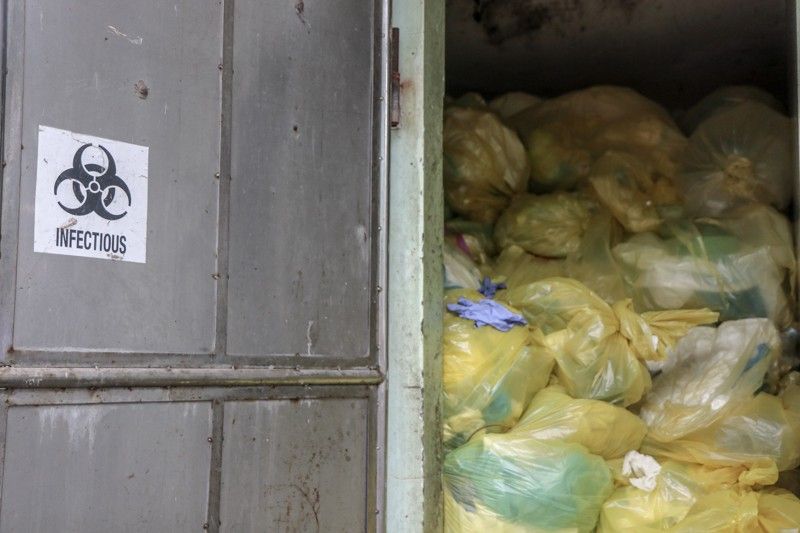
Part 1 of a two-part feature. Read Part 2 here.
MANILA, Philippines (Updated June 17, 2020, 8:38 a.m.) — Since the coronavirus disease (COVID-19) pandemic began in the Philippines, San Lazaro Hospital in Manila City—one of the government hospitals at the forefront of the country’s battle against the severe respiratory illness—has been generating an average of 10,000 kilograms of infectious medical waste every month.
From March to June, it produced an estimated 29,473 kilograms of infectious healthcare waste, which according to the Department of Health, includes used personal protective equipment, dressings, swabs, blood bags, urine bags, sputum cups, syringes, test tubes and histopathological waste.
Also treated as infectious waste are liquid waste such as urine, blood and other body fluids.
San Lazaro Hospital, a 500-bed capacity medical facility, has been admitting many of the COVID-19 patients in outbreak epicenter National Capital Region.
It is also one of the laboratories for coronavirus testing in the Philippines.
When Philstar.com talked to Villacarlos last month, he forecast the hospital may generate 16,000 kilograms of infectious waste in July—about 44% of what was generated from March to July last year when the hospital dealt with measles and dengue outbreaks—as the capital region experiences a spike in COVID-19 cases following the easing of quarantine restrictions.
“[Before the pandemic], we could address the problem of bird flu, SARS, MERS-CoV. All those cases, maybe just one or two at a time. It was easier to address them because the cases stopped soon after,” Tirso Villacarlos, officer-in-charge of San Lazaro Hospital’s general services department, said in Filipino.
Surge in waste seen as cases rise
As COVID-19 cases continue to pile up, putting pressure on hospitals, medical facilities are also seeing a surge in the volume of infectious healthcare waste they produce.
Medical frontliners are clad in personal protective gear to protect themselves and their patients when providing care. In the case of San Lazaro Hospital, an average of 12 PPE sets are used for one patient in a single day.
A complete PPE set includes coveralls, an N95 mask, gloves, head cover, shoe cover, goggles, a surgical mask and a surgical gown.
At minimum, a medical worker assigned to triage and entry points will have a surgical mask on although face shields, which are reusable, are now also increasingly required.
Environmentalists warned that the additional infectious medical waste could have serious impacts on human health and the environment if not managed properly.
In April, the Asian Development Bank estimated that hospitals in Metro Manila—the region that accounts for at least 55% of the nation’s cases—would generate 280 metric tons of medical waste in a single day.
Before the pandemic struck, healthcare facilities in the capital region had been estimated to produce only 47 metric tons of medical waste daily, with 56%—around 26 tons—of this considered potentially infectious.
Waste that does not come in contact with patients, like that generated from regular housekeeping and office work, is considered general waste and can be handled by municipal waste management services.
Latest data from the Department of Environment and Natural Resources showed that the country has so far generated 19,187.7 metric tons of infectious healthcare waste from April to July 20. The figure, which refers to the waste service providers intend to transport and treat, was based on the special permit to transport submitted by treaters.
Of the figure, only around 29% has been treated and disposed of although the waste has already been hauled from hospitals.
The delay is partly in the capacity that waste treatment and disposal facilities have and partly because waste haulers need permits so the DENR can keep track of where hospital waste goes.
Last year, healthcare facilities in the country produced 88,878.7 metric tons of infectious waste.
“There’s really a surge,” Geri Sañez, chief of the DENR hazardous waste management section, said in an online interview with Philstar.com.
Hospitals outside of outbreak epicenter Metro Manila are also grappling with additional infectious medical waste.
Before the current health crisis, Dr. Paulino J. Garcia Memorial Research and Medical Center—also known as PJG—in Cabanatuan City, Nueva Ecija generated only 3,500 kilograms of infectious medical waste monthly.
As the pandemic continues to rage, the average volume of infectious medical waste produced per month reached around 15,000 kilograms..
Most of the COVID-19 patients in Nueva Ecija, a province north of Metro Manila, are admitted at PJG.
Philip Dasalla, head of the hospital’s engineering and facility management division, said the hospital has had to amend its annual contract with a waste management firm with an additional allotment of 60,000 kilograms because the volume in the contract had already been reached by the second quarter.
‘Consider all waste infectious’
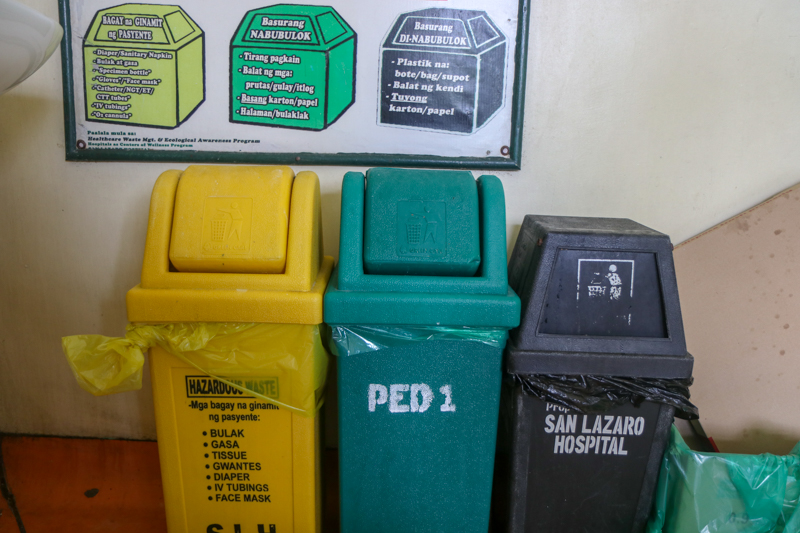
Managing healthcare and household waste can be crucial in successfully containing the disease.
In San Lazaro Hospital, a PPE suit used by a medical frontliner after treating coronavirus patients is discarded in a yellow-lidded bin. The PPE suit, along with other infectious waste in the yellow container, is disinfected with sodium hypochlorite at source, Villacarlos said.
A quarantine facility in San Jose City, Nueva Ecija also employs the use of color-coded trash bins to manage their waste.
San Lazaro Hospital also treats all waste generated in COVID-19 wards even if they are discarded in black bins (non-infectious dry waste) and green bins (non-infectious wet waste) as infectious. This is in line with the guidance of the World Health Organization and the DOH to consider all waste generated in the management of suspect, probable and confirmed COVID-19 patients as infectious waste.
After all, any lapses in the management of medical waste may result in healthcare workers and waste management workers getting infected.
Before it is transferred to the hospital’s waste storage facility, waste generated in COVID-19 wards is once again disinfected. It is stored temporarily in a designated location, which is away from patients and public spaces, before it is picked up for treatment.
Villacarlos said infectious waste from San Lazaro Hospital is hauled daily.
PJG, meanwhile, installed chutes for infectious linen and waste. Medical frontliners at the floor dedicated to COVID-19 cases drop used PPE and linen—all of which could be contaminated by the virus—down the chutes and into bins.
A waste hauler picks them up for treatment weekly. Dasalla said this is to minimize the transportation of infectious healthcare waste within the facility and avoid transmission.
Treatment and disposal
Infectious waste from San Lazaro Hospital then goes to Integrated Waste Management Inc.’s waste treatment facility.
Medical waste in the country is typically disinfected through steam sterilization, also called autoclave, which subjects the waste to intense heat and pressure to kill pathogens—prior to disposal in a landfill. Autoclaves can process between 100 kilograms to as much as 3,000 kilograms per cycle.
“You can always bring ordinary waste to a landfill. However, in healthcare waste management, you need to treat the waste to lessen the risk it poses. This is through disinfection or through the use of an autoclave,” Chito Pacheco, president of service provider Integrated Waste Management, Inc., told Philstar.com in Filipino.
Aside from San Lazaro Hospital, clients of IWMI also include large quarantine facilities such as Philippine Arena in Bulacan and World Trade Center in Pasay City, where mild and asymptomatic cases are isolated to relieve pressure on hospitals.
Other service providers also use pyrolysis or the process of chemically decomposing organic materials at elevated temperatures without oxygen.
In its Health Care Waste Manual, DOH noted that some facilities shred the waste either before or after treatment but added that “shredding the waste simply to render it unrecognizable makes the task more burdensome and more expensive than necessary.”
Treated healthcare waste is then transported to a licensed sanitary landfill for final disposal in a cell dedicated for infectious waste. According to the DOH, treated infectious waste must not be mixed with municipal waste or non-hazardous waste.
The final destination of waste from San Lazaro Hospital and PJG is Metro Clark Waste Management Corp. in Capas, Tarlac.
Treated waste that comes in the facility is again disinfected in the landfill. This process is repeated while the waste is being disposed of in a special cell before it is buried.
“Right now, there is preponderance of healthcare waste so we are very meticulous when it comes to that. It’s a little tedious but it works,” Victor Hontiveros, MCWMC vice president for administration, told Philstar.com in an online interview.
.jpg)
Household waste management
With most people confined to their homes, the public is urged to practice proper waste segregation to prevent the further spread of COVID-19 in their communities and to keep waste management workers safe as well.
While the WHO said there is no direct evidence that direct, unprotected human contact during the handling of healthcare waste has resulted in the transmission of the virus, it noted that waste workers should wear long-sleeved gown, heavy-duty gloves, boots, mask and goggles or face shield and perform hand hygiene.
The DENR urged households to dispose of used face masks, gloves and other protective gear in a separate container and to inform garbage collectors of its potentially infectious content.
Republic Act 9003, or the Ecological Solid Waste Management Act of 2000, already requires the mandatory segregation of solid waste at source into containers labeled as “compostable,” “non-recyclable,” “recyclable,” or “special waste.” The DENR, however, acknowledged there are lapses in the implementation of the law.
In an advisory, DENR’s Environmental Management Bureau said households who have suspect COVID-19 cases or patients under home quarantine must disinfect masks and gloves with a chlorine-based solution prior to collection.
“If [segregation] is important before the coronavirus, it’s even more important now because we’re dealing with infectious waste in households,” Paeng Lopez, Health Care Without Harm campaigner, said.
“What we’re trying to do here is ‘flatten the curve’ (of rising cases). If we’re not careful then that’s another leak, potential leak in our health system that would negate all our efforts to reduce the infection in our waste,” he added.
Volume reduction
Luzon, where many of the country’s urban centers are, can handle the increased volume of medical and infectious waste, the chief of DENR’s hazardous waste management section said. The challenge lies in Visayas and Mindanao.
There are at least 26 registered treatment, storage and disposal (TSD) facilities nationwide, a fourth of which are located in Luzon.
There are no TSD facilities in the provinces of Cagayan Valley and the Bicol region, however.
Farther south, the Eastern Visayas region, and Zamboanga Peninsula and Soccsksargen in Mindanao do not have waste treatment centers.
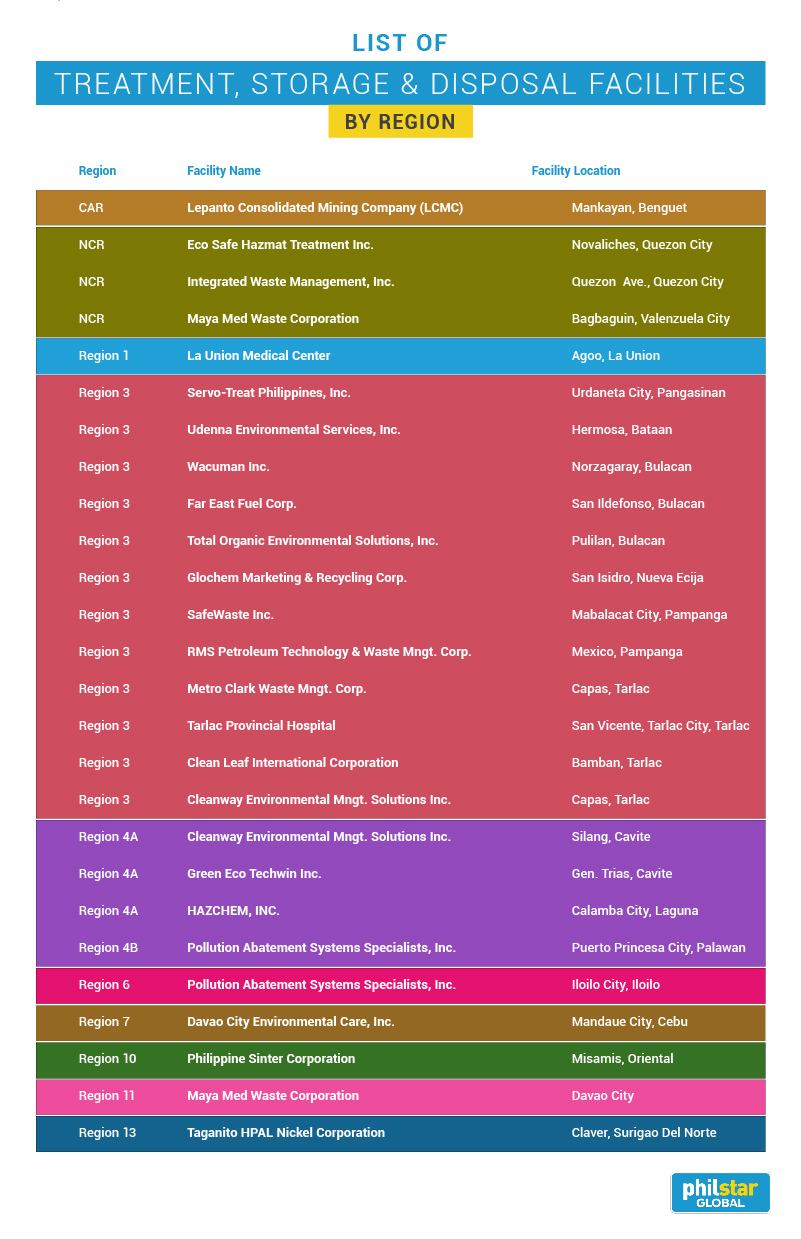
“We have directed regional offices to assess their capacity because the formal treatment facilities are concentrated in Luzon and not all regions in Luzon will have access to a formal treatment facility,” Sañez said.
There may be TSD facilities outside Luzon, “but healthcare is not part of their business,” Sañez said.
“So we are encouraging them if they can invest on [processing healthcare waste].”
Sañez believes the pandemic may strain licensed landfills in the country. For the DENR official, volume reduction through burning of waste is needed.
“Time will come that our landfills will reach capacity because volume will be too high and there is no reduction. You’ve treated the waste but you didn’t reduce it,” Sañez said.
“If there will be no volume reduction at the rate this waste is generated, there will be competition between municipal solid waste and hazardous waste for land disposal,” he added.
Hontiveros is confident, though, that the health crisis will not overwhelm Metro Clark, the country’s first engineered sanitary landfill.
“In terms of space, we don’t have a problem. We have plenty of that.”
Environment Undersecretary Benny Antiporda, who oversees local government units and solid waste management,also told Philstar.com the country can still accommodate the additional medical waste.
Antiporda said the government is looking into building between 10 and 30 sanitary landfills to help ease pressure on the existing ones. It, however, takes at least six months to build a sanitary landfill, he said.
Incineration is only an option for a worst-case scenario, Antiporda said.
“That might be Plan Z,” he said.
But for environmentalists, incineration is never an option because it will add to pollution in the air.
Incineration also a public health concern
Burning of waste is prohibited under the country’s Clean Air Act of 1999.
“Incineration, hereby defined as the burning of municipal, bio-medical and hazardous wastes, which emit poisonous and toxic fumes, is hereby prohibited,” the law states.
However, Sañez said incineration processes that comply with standards can be allowed.
“If the incineration facility will have the proper pollution control technology and will comply with incineration standards, then incineration is not banned,” he said.
But in a letter addressed to environmental groups and obtained by Philstar.com, the DOH has said there is a ban on biomedical waste incineration, which it said in April “is completely up against the Clean Air Act and the DOH’s response to the global call of minimizing the carbon footprint of the health sector while continuing to provide quality public health and safety.”
The government is also pushing for the adoption of waste-to-energy (WTE) treatment facilities to deal with solid waste, which according to environmental lawyer Gloria Estenzo-Ramos is “illegal and harmful.”
“WTE is not a solution. It causes pollution and in the time of COVID-19, the pollution in the air aggravates those who are suffering from asthma, respiratory illness,” Estenzo-Ramos, who is also the vice president of non-profit Oceana Philippines, told Philstar.com.
“Instead of providing a solution, we’re actually creating a whole new problem. Thousands of Filipinos die due to air pollution and adding incineration as another waste management, we just add to that death toll,” Greenpeace zero waste campaigner Marian Ledesma also said.
Both organizations stressed there are sustainable solutions such as the proper implementation of the solid waste program and the shift to reusables from disposables.
“There are green solutions. How come the government turns a deaf ear on them?” Estenzo-Ramos said.
But for now, there is a need to slow the spread of the virus that has so far infected more than 157,000 people in the country to ease pressure on hospitals.
“We need to prevent the spread of the disease to lessen the generation of healthcare waste,” Sañez said.
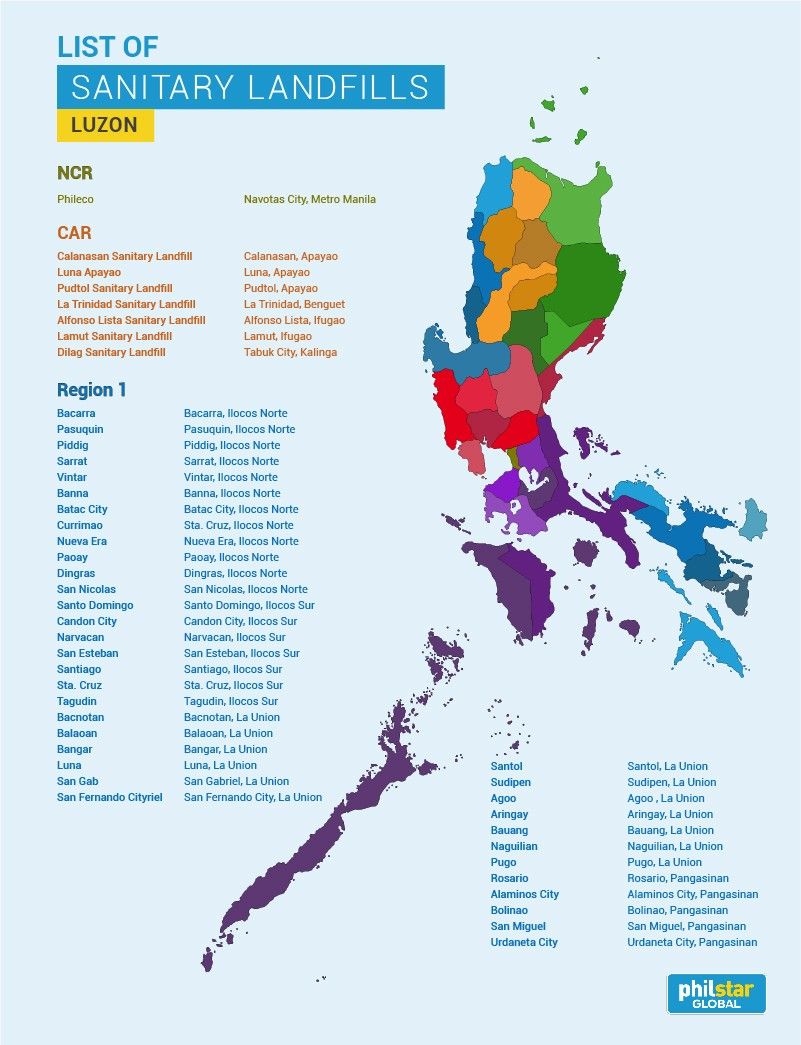

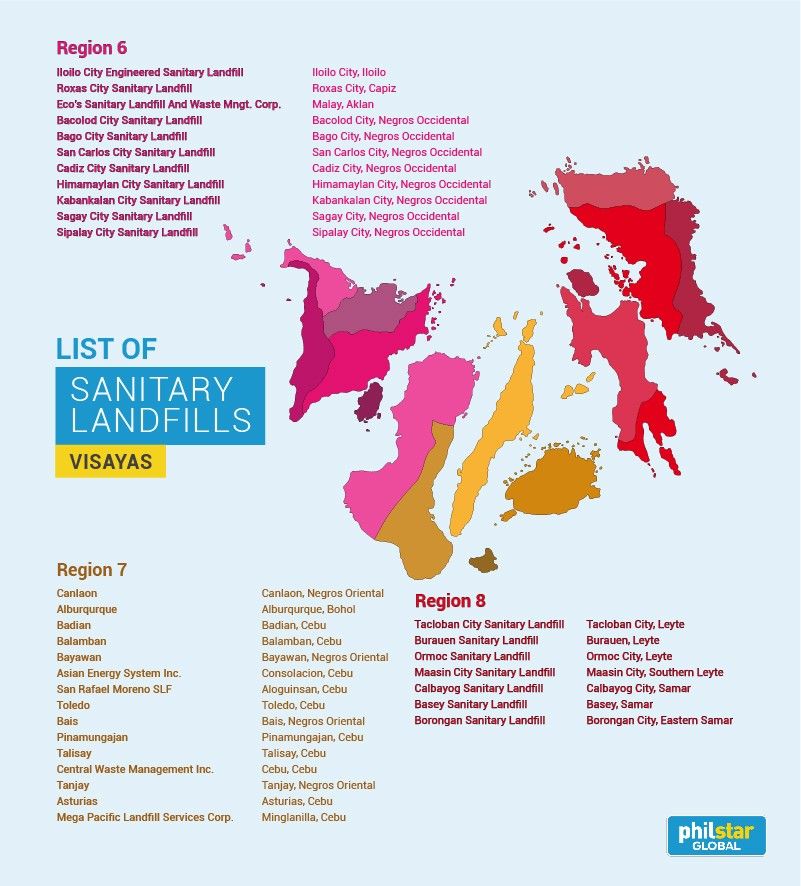
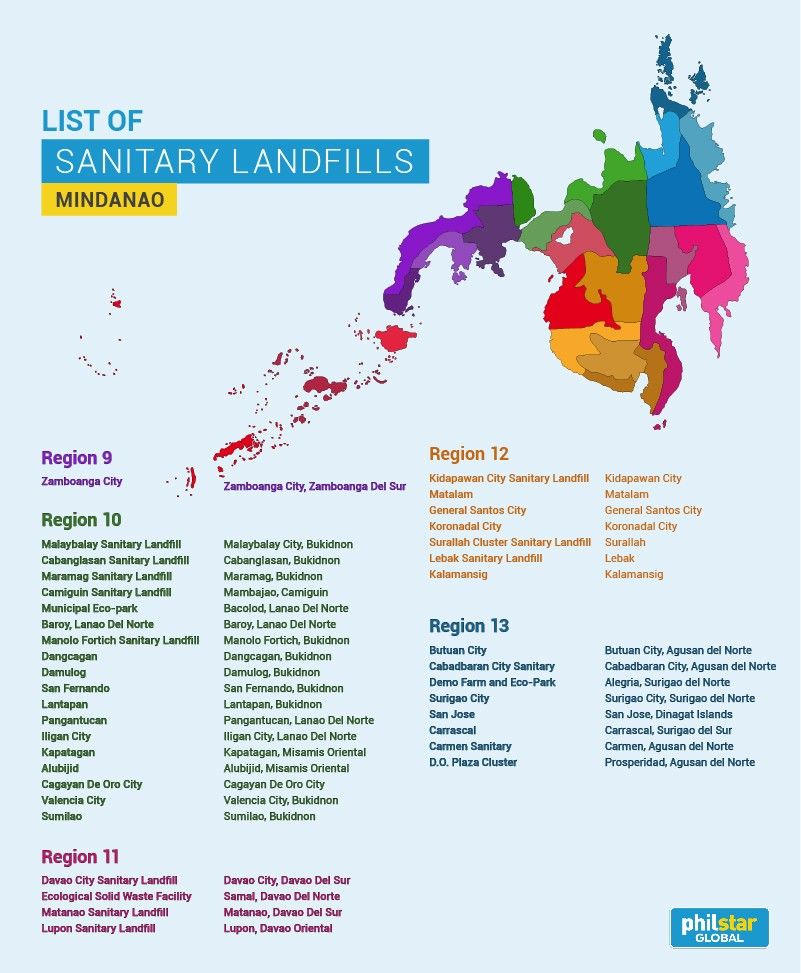
Reporting for this story was supported by Internews’ Earth Journalism Network.
- Latest
- Trending



























